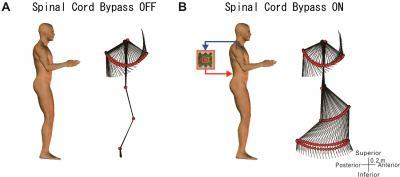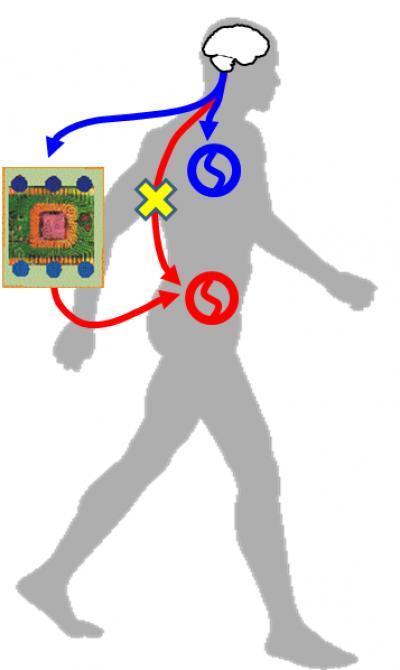Neural networks in the spinal cord, locomotion center are capable of producing rhythmic movements, such as swimming and walking, even when isolated from the brain. The brain controls spinal locomotion center by sending command to the spinal locomotion center to start, stop and change waking speed. In most cases of spinal cord injury, the loss of this link from the brain to the locomotion center causes problems with walking.
The research group came up with bypassing the functioning brain and locomotion center with the computer to compensate lost pathways as a way to enable individuals with spinal cord injury to regain walking ability.
Since the arm movement associte with leg movement when we walk they used muscle activity of arm to sarogate the brain activity. The computer interface allowed subjects to control magnetic stimulator that drive to the spinal locomotion center non-invassively using volitionally-controlled muscle activity and to control walking in legs. As a results of experiments in people who are neurologically intact, the subjects were asked to make own legs relaxed and passively controlled via computer interface that was controlled by arm muscle, walking behavior in legs was induced and subjects could control the step cycle volitionally as well. However without bypassing with the computer interface, the legs did not move even if the arms muscle was volitionally acivated.

The right arm muscles and the locomotion center of the man are artificially connected through a computer. His legs are in a relaxed state. When he moves his right hand, the computer catches the signal from his arm and produces signals to his locomotion center to move his legs.
(Photo Credit: © Yukio Nishimura)
"We hope that this technology would compensate for the interrupted pathways' function by sending an intentionally encoded command to the preserved spinal locomotor center and regain volitionally-controlled walking in indviduals with paraplegia. However, the major challenge that this technology does not help them to dodge obstacles and to maintain posture. We are carefully working toward clinical application in near future", Nishimura said.

When turning off the computer-aided spinal cord bypass, the lower extremities which were in a relaxed state did not move even if the subject was swinging his/her arms. With the bypass turned on, when the subject swung his/her arms by his/her own will and a walking motion of the lower extremities began in rhythm to the motion of the arms.
(Photo Credit: © Yukio Nishimura)

This image shows an artificial connection that connects brain to spinal circuits.
(Photo Credit: © Yukio Nishimura)